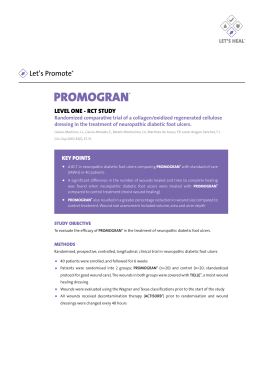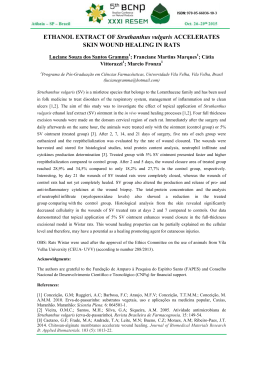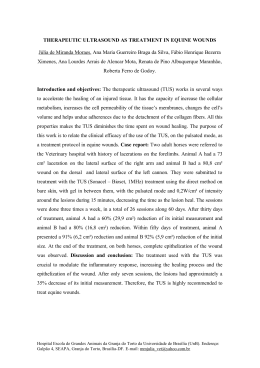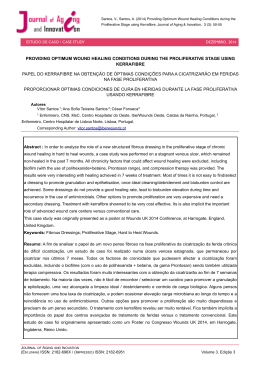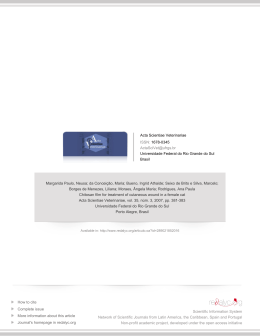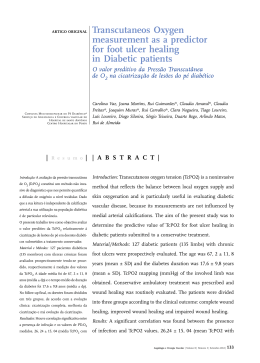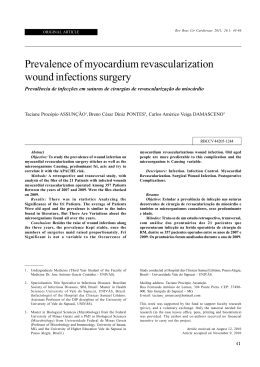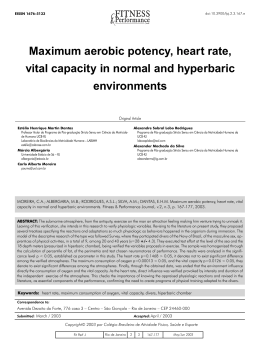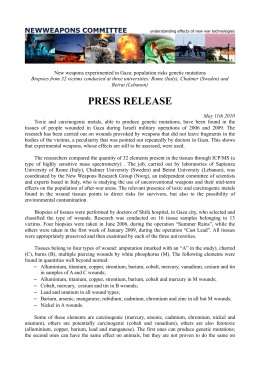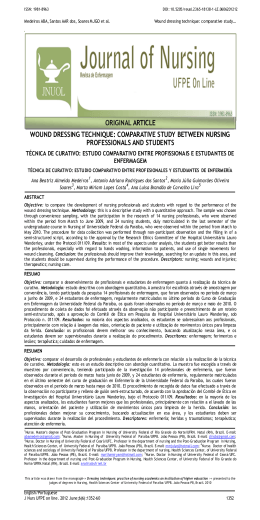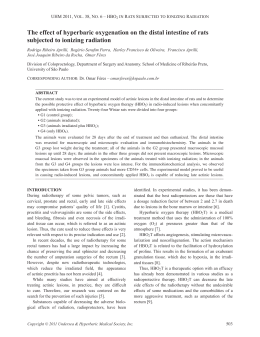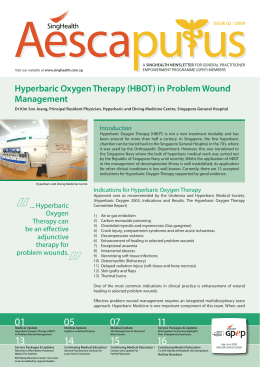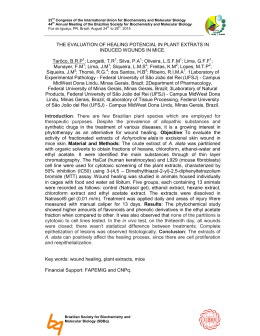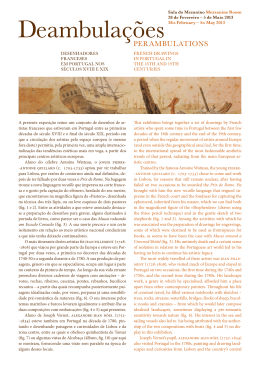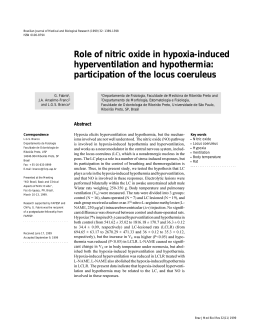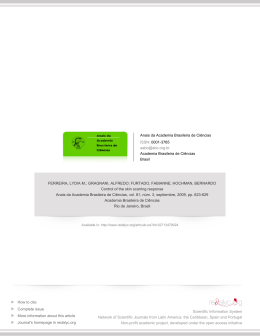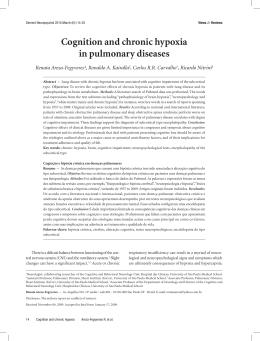89548_NBS 11/21/06 10:50 AM Page 12 H Y P E R BA R I C M E D I C I N E S E R V I C E C A S E O F T H E M O N T H A series of case presentations identifying the improved clinical and cost outcomes that characterize the addition of hyperbaric oxygen therapy to standard medical and surgical measures, in carefully selected patients. A 58 y/o BM with a history of diabetes mellitus was referred to the hyperbaric medicine service for evaluation and treatment recommendations for a chronic foot wound. The patient was initially diagnosed with necrotizing fasciitis of the lower extremity for which he underwent debridement of necrotic tissue. He was subsequently found to have an underlying osteomyelitis with bone biopsies positive for Group B Streptococcus. Despite aggressive wound care, his wound failed to heal. Significant Medical and Surgical History: Hypertension; insulin dependent diabetes mellitus (x 10 years); right ankle open reduction and internal fixation; repairs of a left patella fracture and a left shoulder rotator cuff. Fig. 1 Review of Systems: A well-healed surgical scar was present over the distal right leg. A 9x5 cm surgical incision was evident over the dorsum of the foot extending distally from the mid-foot to the fourth and fifth metatarsal heads. Exposed extensor tendon was also noted proximal to the 4th and 5th digits (Fig. 1). Granulation tissue was noted over the medial aspect of the surgical wound with a modest amount of fibrinous exudate. The dorsalis pedis pulse was unobtainable secondary to the surgical incision transecting this area. A modest sensory polyneuropathy was noted. Transcutaneous Oxygen Evaluation: A transcutaneous oxygen study was conducted. Peri-lesional tissue oxygen states during air breathing (21% oxygen) were consistent with modest hypoxia, sufficient in degree to adversely influence oxygen-dependent wound healing. Response to 100% oxygen inhalation was consistent with a modest arterial inflow compromise. Fig. 2 Assessment: i Status-post debridement ii Group B Strep osteomyelitis iii Wagner Grade 3 diabetic foot lesion iv Reversible wound hypoxia v No patient specific risks for hyperbaric oxygenation vi Lack of an adequate healing response to standard care (debridement; I.V. Rocephin via PICC line; glycemic monitoring, local care with Panafil, offloading and elevation, wound vac.) Recommendations: i Institute daily hyperbaric oxygen, per diabetic foot wound treatment algorithm ii In-chamber transcutaneous oxygen study to confirm minimum required tcPo2 value of 200 mmHg is exceeded iii Reevaluate following 20 treatments iv Maintain present local wound care Fig. 3 These recommendations were agreed to by the patient and his primary/referring specialists. The informed consent process was completed. Hyperbaric treatment was initiated per protocol. Periwound tissue oxygen levels recorded during the initial treatment were encouraging, exceeding 550 mmHg. The second treatment was complicated by ear pain (secondary to chamber compression). ENT consult was obtained and ventilation tubes placed. No further ear discomfort was reported. By treatment number seven a beefy granulation tissue filled the wound base (Fig 2). Treatments continued uneventfully. By treatment number 20 granulation tissue filled the wound. Epithelialization was underway (Fig 3). At this point the patient appeared to be close to the point of maximum benefit from hyperbaric oxygen. It was elected to hold further therapy and follow the patient with weekly return visits to confirm continued spontaneous healing. Those follow-ups, at week two (Fig 4) and week six (Fig 5), were consistent with an excellent healing response. The patient was discharged from the hyperbaric medicine service at this point, to the follow-up care of his primary care physician. Discussion: Diabetic patients are particularly prone to wound healing deficiencies. Several factors serve to complicate the healing process and threaten the extremity, most notably hypoperfusion and local wound hypoxia(1). Transcutaneous oximetry testing serves to quantify any wound oxygen delivery shortcomings(2). In the context of the hyperbaric referral, transcutaneous oximetry will also identify those who have the physiologic capacity to respond locally to centrally delivered hyperbaric oxygen (by the process of a 100% oxygen challenge demonstrating brisk reversal of peri-wound hypoxia). Hyperbaric oxygen therapy has been demonstrated to accelerate healing wounds complicated by hypoxia(3), produce an enduring healing effect(4), and lower the incidence of amputation in diabetic patients(5). The patient described above was instructional in several respects. His infective process was quickly identified, prompting hospitalization and aggressive surgical and medical management. His subsequent clinical INDICATIONS course was complicated by a poorly healing surgical wound despite standard care. Referral to hyperbaric medicine was appropriate at this Indications point, and consistent with clinical and insurance compliance standards. Local tissue hypoxia was identified as was its reversibility Acute carbon monoxide poisoning (appropriateness to undergo HBO therapy). In-chamber tissue oxygen Acute exceptional blood loss anemia values confirmed that the necessary therapeutic range of hyperoxygenation had been achieved. Healing responses were identified Acute thermal burns early in the treatment course and a therapeutic endpoint was reached at 20 treatments. HBO therapy was held at this point and continued Cerebral arterial gas embolism spontaneous healing to complete resolution was recorded over the next several weeks. Chronic osteomyelitis In summary, the addition of hyperbaric medicine, applied along an algorithmic pathway, produced the necessary angiogenic and antimicrobial responses to heal an otherwise refractory soft tissue lesion Clostridial gas gangrene in a patient at considerable risk for amputation. References: (Available upon request) 1) Levin ME.: Management of the Diabetic Foot: Preventing Amputation. Southern Med J 2002; 95(1):10-20. 2) Reiber G, Pecoraro R, Koepsell T.: Risk Factors for Amputation in Patients with Diabetes Mellitus. Annals of Internal Medicine 1992; 117(2):97-105. 3) Niinikoski J.: Hyperbaric Oxygen Therapy of Diabetic Foot Ulcers, Trancutaneous Oxymetry in Clinical Decision Making. Wound Rep Reg 2003; 11:458-461. 4) Kalani M, Jorneskog G, Naderi N, et al.: Hyperbaric Oxygen (HBO) Therapy in Treatment of Diabetic Foot Ulcers. Long Term Follow-Up. J Diabetes and its Complications 2002; 16:153-158. 5) Roeckl-Wiedmann I, Bennett M, Kranke P.: Systematic Review of Hyperbaric Oxygen in the Management of Chronic Wounds. British Journal of Surgery 2005; 92:24-32. Fig. 4 Fig. 5 AND RATIONALE FOR HBO THERAPY * Rationale Relieve hypoxia; hasten elimination of CO; antagonize brain lipid peroxidation Increase physically dissolved oxygen; treat hypoxia; support marginally perfused tissues Relieve hypoxia; decrease fluid losses; limit burn wound extension and conversion; treat edema; promote wound closure Overcome free gas volume; relieve hypoxia; antagonize leukocyte mediated ischemia-reperfusion injury Augment host antimicrobial defenses; induce angiogenesis; potentiate leukocytic dismutase superoxide and perioxide production; relieve hypoxia; augment antibiotic therapy; extend post-antibiotic effect; augment osteoclast activity Reduce size of gaseous bullae; inactivate clostridial alpha toxin; inhibit alpha toxin production; induce bacteriostasis; potentiate leukocytic dismutase superoxide and perioxide production Compromised skin flaps Support marginally perfused/oxygenated tissues; antagonize ischemic-reperfusion injury; accelerate angiogensis Crush injury; acute ischemia Provide interim tissue oxygenation in relative states of ischemia; reduce edema; reduce compartment pressures; antagonize ischemic-reperfusion injury; augment limb salvage Decompression sickness Overcome free gas volume- induced ischemia; relieve hypoxia; hasten elimination of offending inert gas; treat edema Late radiation tissue injury Re-establish wound oxygen gradients; relieve hypoxia; induce angiogenesis; prepare for definitive coverage Late radiation tissue injury prophylaxis Re-establish wound oxygen gradients; induce angiogenesis prior to surgical wounding Necrotizing soft tissue infections Induce bacteriostasis of anaerobes; (fasciitis and cellulitis) potentiate leukocytic dismutase superoxide and perioxide production; relieve hypoxia; more closely demarcate potentially viable tissue Non-healing marginally perfused wounds Re-establish wound oxygen gradients; relieve hypoxia; reduce edema; induce angiogenesis; correct diabetic-induced leukocyte changes; prepare for definitive coverage *UNDERSEA AND HYPERBARIC MEDICAL SOCIETY, 2003
Download
